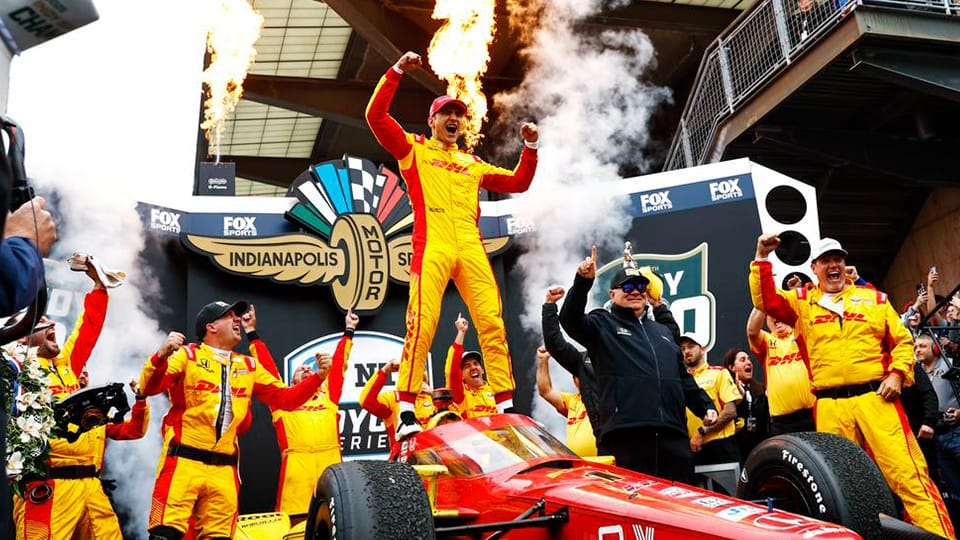The Penske Principle: How Real Leaders Choose Integrity Over Legacy
TL;DR: Roger Penske fired his own successor to save the sport's integrity. The cost? His legacy plan. Here's how leaders make brutal decisions with clarity, compassion—and a 10-week system to get it right.

The Blackhawk helicopters came in so low at Indianapolis that fans in the upper decks looked down at their rotors. 230,000 people watching military precision mere feet above the world's largest spectacle. Rain had just started falling on the 109-year-old bricks as the jets screamed overhead.

Then Roger Penske made a decision that stunned the racing world.
At 87, after building a $3.2 billion empire and owning the Indianapolis 500 for five years, Penske fired his chosen successor. Not for incompetence. Not for a single catastrophic failure. But for a pattern of small violations that threatened the sport's integrity.
Penske destroyed his own legacy plan to preserve something bigger than himself.
You may never own a racetrack, but if you're leading a team at Amazon, Meta, or anywhere high stakes, you'll face the same choice: protect the mission or protect the person.
The Weight of Choosing
Every leader faces this moment: when protecting your team means making someone else pay the price. When being kind to one person means being cruel to everyone else.
I've sat through too many "performance improvement" meetings that were really just elaborate ways to manage people out. I've watched Amazon leaders pervert "Raise the Bar" into a weapon for getting rid of anyone who questioned their metrics. I've been the person who had to shield a team member with medical issues for months - supporting different hours, medical leaves, discretionary time off - while simultaneously protecting his teammates from his mistakes and senior executives from his impact.
The hardest part? He wasn't a fan of mine throughout the process. Still isn't, probably.
But here's what I learned: every coaching situation creates a tension between the human in front of you and the team depending on you. Your job isn't to choose sides. It's to assess if they're helping or hurting the collective mission - and then act with both courage and compassion.
Without that assessment framework, you're just flying blind with good intentions.
The Amazon Principle That Actually Works
At Amazon, "Earn Trust" isn't a warm-fuzzy. It's an execution filter. If a report can't be vocally self-critical by week 4, they're a liability. Not because they're bad—but because they can't get better fast enough.
I learned this the hard way coaching a brilliant engineer who kept missing critical deadlines. Three months of "performance improvement," gentle feedback, additional resources. The team started covering for him. Other engineers began questioning why standards didn't apply equally.
Leaders listen attentively, speak candidly, and treat others respectfully. They are vocally self-critical, even when doing so is awkward or embarrassing.
That phrase - "vocally self-critical" - became my litmus test. He couldn't honestly assess his own performance gaps. No amount of coaching was going to save him.
Or the team.
The SBI Framework That Changed Everything
Here's the system I wish I'd had 20 years ago, refined through hundreds of coaching conversations:
Situation → Behavior → Impact → Intent
Not the typical SBI you learned in management training. This version includes Intent - because understanding someone's motivation determines whether coaching can work.
Real Examples from My Coaching Plans:
Example 1: The Chronic Late Deliverer
Situation: "In the last three sprint reviews..."
Behavior: "...your demos weren't working, requiring the team to scramble with backup presentations..."
Impact: "...which made us look unprepared to stakeholders and cost the team 4 hours of emergency prep work..."
Intent: "Help me understand what's happening in your process that's causing this pattern."
Result: If they blame others or make excuses, they're not ready for coaching. If they say "I've been trying to perfect everything and losing sight of 'good enough,'" there's hope.
Example 2: The Meeting Dominator
Situation: "In yesterday's architecture review..."
Behavior: "...you interrupted Sarah three times and spent 15 minutes on implementation details when we needed to decide on the approach..."
Impact: "...which meant we ran out of time for the database decision and Sarah shut down for the rest of the meeting..."
Intent: "What were you trying to accomplish in that moment?"
Response indicator: Self-awareness ("I get excited and lose track of the room") vs. defensiveness ("Sarah wasn't explaining it clearly").
The AI Enhancement System
💻 AI Stack for Bulletproof Coaching
Use this 3-step AI workflow to document and defend tough coaching decisions:
Otter.ai (Weeks 1–3): Capture behavior + tone ($10/month)
Ethan Evans AI Coach: Validate your coaching plan (free)
Output = Legal protection + coaching clarity
The Coaching Decision Tree That Actually Works
After 20 years of performance management, here's what determines success:
Week 1-2: Document the pattern with SBI+Intent
Week 3-4: Assess self-awareness vs. blame
Week 5-6: Create development plan with clear metrics
Week 7-8: Measure improvement against specific behaviors
Week 9-10: Make the call
Key Decision Point: If they're not vocally self-critical by week 4, start transition planning. The team can't wait for someone who won't own their impact.
I had one client—a Director at a major tech company—who knew their direct was failing but kept giving them chances. The team burned out covering extra work. The exec got dinged in their promotion review. Why? Because they confused being nice with being fair to everyone else.
The Compassionate Exit: Sometimes the kindest thing - for everyone - is creating a graceful transition that preserves dignity while protecting team performance.
That team member with medical issues? We worked together on a package that let him focus on his health without work stress. He didn't have to worry about rent. The team didn't have to carry his workload indefinitely. Senior executives got predictable outcomes.
Not everyone was happy. But everyone was taken care of, within the constraints of what was actually possible.
🧭 The 10-Week Accountability Playbook
The Penske Principle: Choose integrity over loyalty when the stakes matter most.
SBI+Intent Process:
Document specific situations and behaviors
Articulate clear impact on team/mission
Probe for intent and self-awareness
Assess: Vocal self-criticism or external blame?
AI Documentation Stack:
Otter.ai: Conversation capture ($10/month)
Claude: Pattern analysis ($20/month)
Ethan Evans AI: Coaching validation (free)
Decision Framework:
Decision Timeline: 10 weeks maximum
Success Indicator: Measurable behavior change by week 6
Transition Criteria: No self-awareness by week 4
Remember: Your job is protecting the mission while caring for the human. Sometimes that means making the call that needs to be made.
The race went on. 33 drivers crossed 109-year-old bricks at 230 mph, and Alex Palou won—his 5th victory in 6 races this year, continuing a dominance that's earned him 3 of the last 4 championships. Excellence rewarded because the rules mattered more than relationships.

If you're still "hoping it improves" after week 4, you're leading with hope, not discipline. Hope is not a strategy. This framework is.
What behavior have you documented—but still avoided acting on? And who's paying the price for your hesitation?
Building Black Line MTB Apparel has taught me that accountability in business—like racing—requires both precision and courage. Sometimes the hardest decisions protect what matters most.





